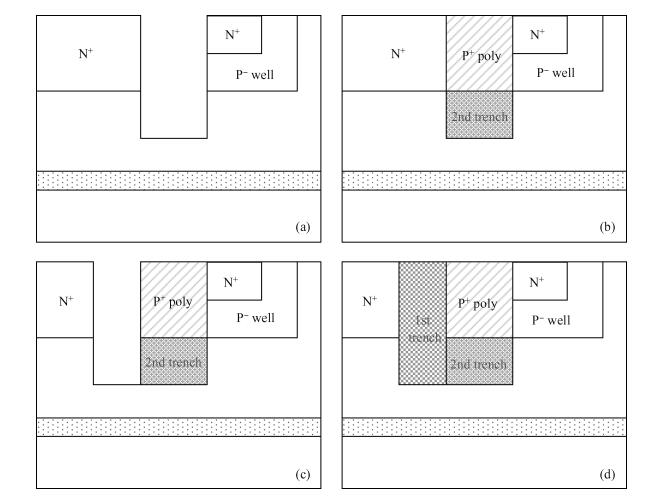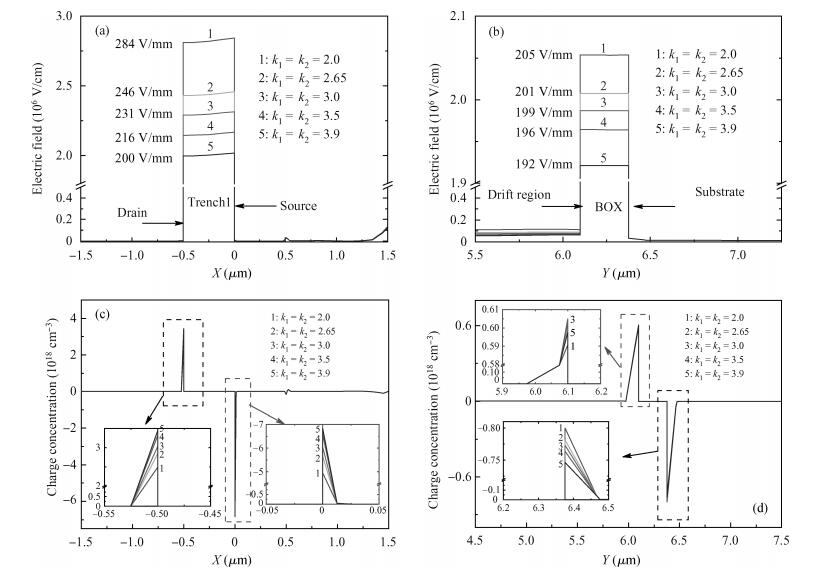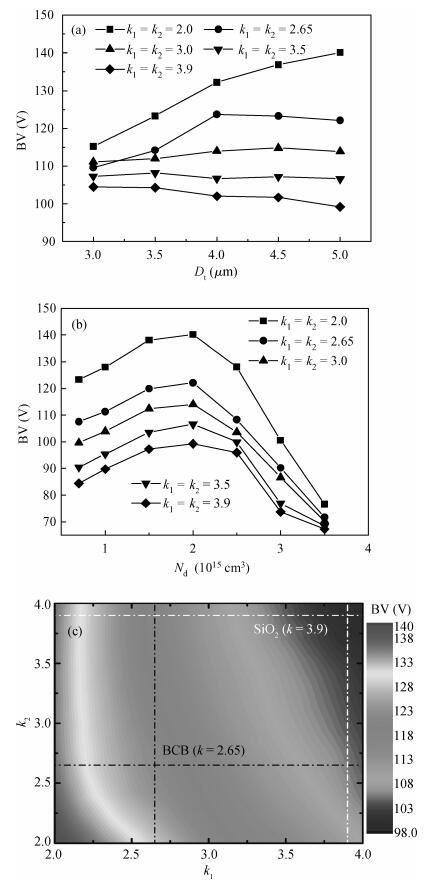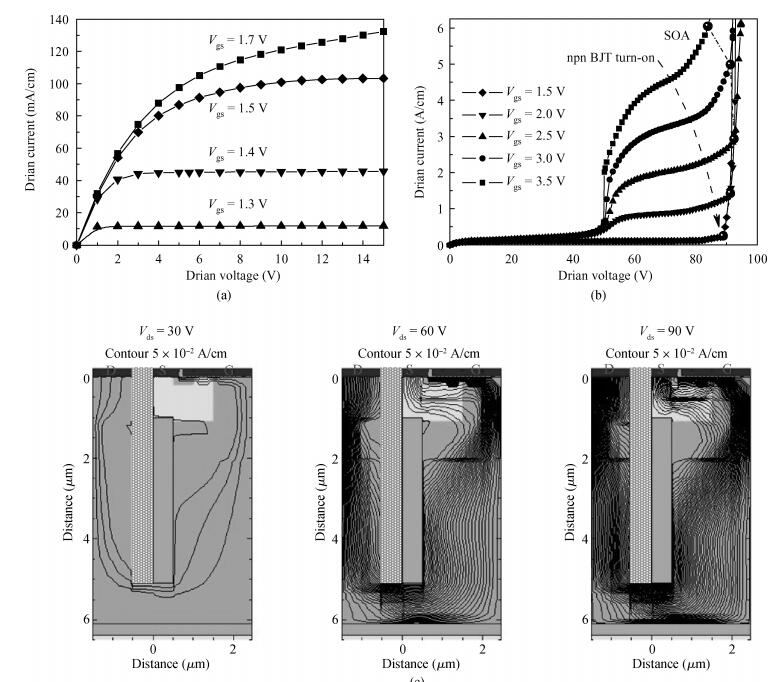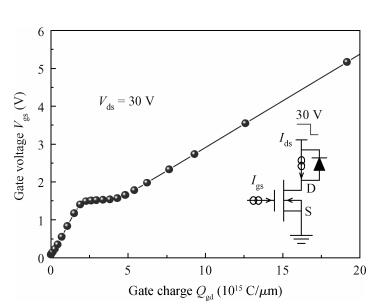| Citation: |
Zhigang Wang, Bo Zhang, Zhaoji Li. Analysis of OFF-state and ON-state performance in a silicon-on-insulator power MOSFET with a low-k dielectric trench[J]. Journal of Semiconductors, 2013, 34(7): 074006. doi: 10.1088/1674-4926/34/7/074006
****
Z G Wang, B Zhang, Z J Li. Analysis of OFF-state and ON-state performance in a silicon-on-insulator power MOSFET with a low-k dielectric trench[J]. J. Semicond., 2013, 34(7): 074006. doi: 10.1088/1674-4926/34/7/074006.
|
Analysis of OFF-state and ON-state performance in a silicon-on-insulator power MOSFET with a low-k dielectric trench
DOI: 10.1088/1674-4926/34/7/074006
More Information
-
Abstract
A novel silicon-on-insulator (SOI) MOSFET with a variable low-k dielectric trench (LDT MOSFET) is proposed and its performance and characteristics are investigated. The trench in the drift region between drain and source is filled with low-k dielectric to extend the effective drift region. At OFF state, the low-k dielectric trench (LDT) can sustain high voltage and enhance the dielectric field due to the accumulation of ionized charges. At the same time, the vertical dielectric field in the buried oxide can also be enhanced by these ionized charges. Additionally, ON-state analysis of LDT MOSFET demonstrates excellent forward characteristics, such as low gate-to-drain charge density ( < 0.6 nC/mm2) and a robust safe operating area (0-84 V). -
References
[1] Luo X, Zhang B, Li Z, et al. A novel 700-V SOI LDMOS with double-sided trench. IEEE Electron Device Lett, 2007, 28:422 doi: 10.1109/LED.2007.894648[2] Luo X R, Yao G L, Chen X, et al. Ultra-low on-resistance high voltage (> 600 V) SOI MOSFET with a reduced cell pitch. Chin Phys B, 2011, 20(2):028501 doi: 10.1088/1674-1056/20/2/028501[3] Ren M, Li Z H, Liu X L, et al. A novel planar vertical double-diffused metal-oxide-semiconductor field-effect transistor with inhomogeneous floating islands. Chin Phys B, 2011, 20(12):128501 doi: 10.1088/1674-1056/20/12/128501[4] Wang C L, Sun J. An oxide filled extended trench gate super junction MOSFET structure. Chin Phys B, 2009, 18(3):1231 doi: 10.1088/1674-1056/18/3/065[5] Luo Xiaorong, Zhang Wei, Gu Jingjing, et al. A new double gate SOI LDMOS with a step doping profile in the drift region. Journal of Semiconductors, 2009, 30:084006 doi: 10.1088/1674-4926/30/8/084006[6] Radhakrishna U, DasGupta A, DasGupta N, et al. Modeling of SOI-LDMOS transistor including impact ionization, snapback, and self-heating. IEEE Trans Electron Devices, 2011, 58:4035 doi: 10.1109/TED.2011.2165724[7] Son W S, Sohn Y H, Choi S Y. SOI RESURF LDMOS transistor using trench filled with oxide. Electron Lett, 2003, 39:1760 doi: 10.1049/el:20031115[8] Leung Y K, Paul A K, Goodson K E, et al. Heating mechanisms of LDMOS and LIGBT in ultrathin SOI. IEEE Electron Device Lett, 1997, 18(9):414 doi: 10.1109/55.622514[9] Bremmer J N. Emergence of ultra low-k. Solid State Technol, 2001, 44:S3 doi: 10.1094/PHYTO-07-12-0166-R[10] Murthy B R, Mukherjee-Roy M, Krishnamoorthy A, et al. Reactive ion etching and characterization of p-silk ultra low-k film. IEEE Trans Semicond Manuf, 2005, 18:174 doi: 10.1109/TSM.2004.840537[11] Luo X, Udrea F, Wang Y, et al. Partial SOI power LDMOS with a variable low-k dielectric buried layer and a buried P layer. IEEE Electron Device Lett, 2010, 31(6):594 doi: 10.1109/LED.2010.2046616[12] Lubguban J J, Seitob A, Kurata Y, et al. Stability of the dielectric properties of PECVD deposited carbon-doped SiOF films. Thin Solid Films, 1999, 337(1/2):67[13] Yoneda K, Kato M, Nakao S, et al. Robust low-k diffusion barrier (k=3.5) for 45-nm node low-k (k=2.3)/Cu integration. Proc Interconnect Technology Conference, 2006:184 doi: 10.1007/978-0-387-95868-2_21/fulltext.html[14] Théolier L, Mahfoz-Kotb H, Isoird K, et al. A new junction termination using a deep trench filled with benzocyclobutene. IEEE Electron Device Lett, 2009, 30(6):687 doi: 10.1109/LED.2009.2020348[15] Wang Y, Jiao W L, Hu H F, et al. A gate enhanced power U-shaped MOSFET integrated with a Schottky rectifier. Chin Phys B, 2012, 21(5):056104 doi: 10.1088/1674-1056/21/5/056104[16] Li Xiaorong, Zhang Bo, Li Zhaoji, et al. A novel SOI high voltage device structure with a partial locating charge trench. Chinese Journal of Electronics, 2006, 27(5):881 doi: 10.1007/s10825-017-0994-7[17] Li W Y, Ru G P, Jiang Y L, et al. Trapezoid mesa trench metal-oxide-semiconductor barrier Schottky rectifier:an improved Schottky rectifier with better reverse characteristics. Chin Phys B, 2011, 20(8):087304 doi: 10.1088/1674-1056/20/8/087304[18] Moens P, Boschd G V. Characterization of total safe operating area of lateral DMOS transistors. IEEE Trans Device Mater Reliab, 2006, 6:349 doi: 10.1109/TDMR.2006.882212[19] Khemka V, Parthasarathy V, Zhu R, et al. Experimental and theoretical analysis of energy capability of RESURF LDMOSFETs and its correlation with static electrical safe operating area (SOA). IEEE Trans Electron Devices, 2002, 49:1049 doi: 10.1109/TED.2002.1003740[20] Ren M, Li Z H, Deng G M, et al. A novel superjunction MOSFET with improved ruggedness under unclamped inductive switching. Chin Phys B, 2012, 21(4):048502 doi: 10.1088/1674-1056/21/4/048502[21] Zhang B, Xu Z, Huang A Q. Forward and reverse biased safe operating areas of the COOLMOSTM. Proc Power Electronics Specialists Conference, 2000, 1:81 https://library.e.abb.com/public/36b54722849cde16c125786300269429/Surge%20currents%20for%20IGBT%20diodes_%205SYA%202058-02.pdf[22] Yin Shan, Qiao Ming, Zhang Yongman, et al. Design of 700 V triple RESURF nLDMOS with low on-resistance. Journal of Semiconductors, 2011, 32:114002 doi: 10.1088/1674-4926/32/11/114002[23] Li Z J, Zhang B, Luo X R, et al. The rule of field enhancement for buried dielectric layer of SQl high voltage devices. Proc ICCCAS, 2007:1302[24] Zhang B, Li Z, Hu S, et al. Field enhancement for dielectric layer of high-voltage devices on silicon on insulator. IEEE Trans Electron Devices, 2009, 56:2327 doi: 10.1109/TED.2009.2028405[25] Wu L J, Hu S D, Luo X R, et al. Partial-SOI high voltage P-channel LDMOS with interface accumulation holes. Chin Phys B, 2011, 20(10):107101 doi: 10.1088/1674-1056/20/10/107101[26] Tang Z, Ye P D, Lee D, et al. Electrical measurements of voltage stressed Al2O3/GaAs MOSFET. Microelectron Reliab, 2007, 47(12):2082 doi: 10.1016/j.microrel.2007.02.012[27] Moens P, Van den bosch G. Characterization of total safe operating area of lateral DMOS transistors. IEEE Trans Device Mater Reliab, 2006, 6(3):349 doi: 10.1109/TDMR.2006.882212[28] Pendharkar S, Higgins R, Debolske T, et al. Optimization of low voltage n-channel LDMOS devices to achieve required electrical and lifetime SOA. Proceedings of the 14th International Symposium on Power Semiconductor Devices and ICs, 2002:261 doi: 10.1007/978-3-319-08994-2_11[29] Moens P, Van den Bosch G, De Keukeleire C, et al. Hot hole degradation effects in lateral nDMOS transistors. IEEE Trans Electron Devices, 2004, 51(10):1704 doi: 10.1109/TED.2004.834913[30] Wang P F, Ding S J, Zhang W, et al. CVD technologies used in preparation of low materials for ULSI. Microfabrication Technol, 2001, 1:30[31] Ludikhuize A W. A review of RESURF technology. Proc ISPSD, 2000:11 http://www.ijetae.com/files/Volume4Issue6/IJETAE_0614_26.pdf[32] Cheng J J, Chen X B. Hot-carrier reliability in OPTVLD-LDMOS. Journal of Semiconductors, 2012, 33:064003 doi: 10.1088/1674-4926/33/6/064003[33] Steighner J B, Yuan J S. The effect of SOA enhancement on device ruggedness under UIS for the LDMOSFET. IEEE Trans Device Mater Reliab, 2011, 11(2):254 doi: 10.1109/TDMR.2011.2121068[34] Zhu R, Khemka V, Bose A, et al. Substrate majority carrier-induced NLDMOSFET failure and its prevention in advanced smart power IC technologies. IEEE Trans Device Mater Reliab, 2006, 6(3):386 doi: 10.1109/TDMR.2006.882198[35] Lee C P, Chati F H E, Ma W, et al. The safe operating area of GaAs-based heterojunction bipolar transistors. IEEE Trans Electron Devices, 2006, 53(11):2681 doi: 10.1109/TED.2006.884075[36] In't Zandt M A A, Hijzen E A, Hueting R J E, et al. Record-low 4 mΩ·mm2 specific on-resistance for 20 V trench MOSFETs. Proc ISPSD, 2003:32[37] Jiang Q, Wang M, Chen X, et al. A high-speed deep-trench MOSFET with a self-biased split gate. IEEE Trans Electron Devices. 2010, 57:1972 doi: 10.1109/TED.2010.2051247[38] Rutter P, Peake S T. Low voltage trench MOS combining low specific RDS(on) and QG FOM. Proc ISPSD, 2010:325 doi: 10.1007/978-94-007-1926-2_17 -
Proportional views





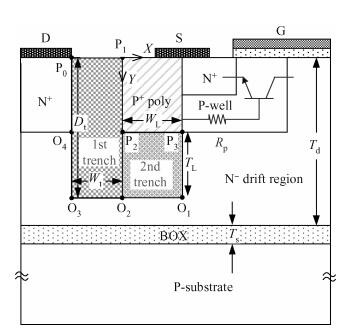
 DownLoad:
DownLoad:
